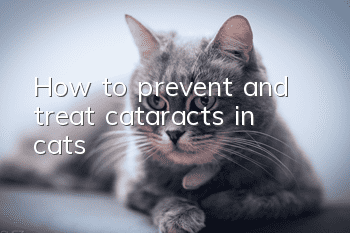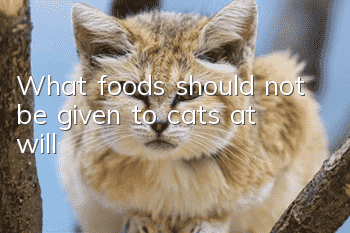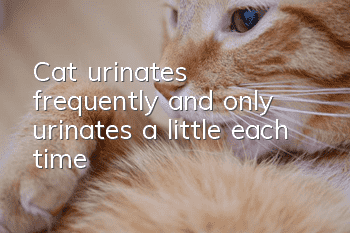How to prevent and treat cataracts in cats

The emergence of cataracts will greatly affect the vision of both eyes (or one eye) of cats. At first, you will only see a layer of milky white turbidity on the surface of the pupil. Slowly, it will prevent light from entering the retina, and finally lead to decreased vision. Even blindness. And the occurrence of cataracts can also cause stress, irritation and other discomforts in cats.
Under normal circumstances, we will associate cataracts with aging, especially senior cats over 7 years old are more likely to suffer from this disease. However, age is only one of the causes of cataracts. Even newborn cats may suffer from cataracts. This abnormality is called "congenital cataracts" and is more commonly caused by eye trauma, infection, inflammation and malnutrition (in young children). cats) and other reasons.
Symptoms of cataracts
The main symptoms of a cat suffering from cataracts depend on the degree of visual impairment. For example, in the early stages of the disease, the visual impairment of cats is usually less than 30%. This degree of visual changes will not cause the cat to feel any changes. Because they can still use their other senses to make up for this, such as smell and hearing. Moreover, there will be no icy blue spots or complete crystals (turbidity) in the cats’ pupils during this period.
Basically when we find it, the cat’s pupils are already ice blue or completely crystallized (turbid). Over time, they develop cracks in the crystals that look like marble patterns, and they begin to behave strangely. (It’s like we see the world through a frosted glass)
· The reaction is slow and not so agile (you can try playing with the cat in front of him and see his reaction)
· Often trip over one’s own feet
· Hitting walls or other objects (furniture, people)
· Unable to determine one’s own footing
· Unusual calls
· Showing signs of stress and anxiety
· Unable to judge distances correctly (sudden unwillingness to jump on furniture or climb stairs)
· Can’t recognize familiar people anymore
· Difficulty finding food bowls or litter boxes
· Unable to move in the dark
· Squinting behavior
Note: It is worth noting that many parents often confuse nuclear sclerosis and cataracts. Cataract is a pathological change that prevents light from passing through the lens, which affects vision and requires surgery;Nuclear sclerosis is a physiological change. Light can pass through the lens, which does not affect vision and does not require surgery.
There will be a small amount of cataracts when the nucleus is hardened
Causes of cataracts
As mentioned above, there are many reasons for cats to suffer from cataracts, including genetics, which is also one of the main factors, and may also be accompanied by other eye defects. Cataracts are a progressive disease that require prompt hospital care.
·Age
Cataracts may also occur spontaneously and become more severe with age, so older cats may be more susceptible to cataracts.
Note: A study of 2,000 pet cats conducted at the University of Cambridge in 2006 found that almost all cats over 7 years old had a certain degree of cloudiness in their pupils.
·Variety
Although all breeds can suffer from cataracts, breeds such as Bengals, Biermans, Persians, Himalayans, etc. are more susceptible to the disease than other cats and have a high genetic risk.
· Eye inflammation/uveitis
This type of cause is one of the most common eye problems in cats. It is usually caused by cat lens puncture due to fighting. If your eyes appear red, squinting, excessive tearing, or cloudy, please rush to the hospital immediately to avoid developing cataracts.
Note: Uveitis is contagious and requires immediate isolation once confirmed.
· Diabetes
This disease is caused by a failure to produce the amount of insulin needed to regulate glucose levels in the cat's body. Not only will cataracts appear, but it can also cause complications such as sudden weight loss, loss of appetite, degradation of the digestive system, vomiting, dehydration, listlessness, and even death.
·Lack of nutrition
Cataracts caused by malnutrition are also a very common cause. Taurine is one of the most important dietary nutrients for cats. Some malnourished homemade diets will increase the risk of cats suffering from cataracts.
·Hypocalcemia
A cat suffering from hypocalcemia means that it has low calcium levels, and cataracts are only the first step in complications. In addition to this, you may also notice that your cat looks a littleAnxiety, stiffness, overreaction to your touch, etc.
·Excessive dehydration
Dehydration is often caused by another medical condition, such as kidney failure, chronic vomiting, and diarrhea.
·Electric shock
Many cats always chew wires out of curiosity. If they bite through the outer layer of wires, they will easily get an electric shock. Although it will definitely be fatal, it will also cause serious health problems such as cataracts, difficulty breathing, coughing, etc.
In addition to the above situations, poisoning, radiation, trauma, etc. can also cause cataracts in cats.
Diagnosis process
When you find that one or both eyes of your cat are cloudy, it is best to take them to the hospital to check the cat’s health in time.
·Tear test
Used to assess the moisture content of the eye, look for possible damage and determine whether the cornea has been damaged.
· Tonometry
It can identify the pressure of fluid in the eye to check for the presence of glaucoma.
· Slit lamp instrument
Used to check whether there are any problems with the lenses and other structures of the eyes.
·Flashlight/other light sources
Assuming normal intraocular pressure, the doctor will usually use eye drops to dilate the cat's pupils and use a flashlight or other light source to evaluate for cataracts.
Before the above eye tests, anesthetic drops are usually applied to the eyes to ensure a painless examination and accurate test results.
Treatment Plan
What we must understand is that the main purpose of treating cataracts is not to restore vision, but to prevent secondary problems such as uveitis (with the risk of infection), glaucoma and retinal detachment.
Cats under five conditions are not recommended to undergo surgery.
· Cataract has not yet reached the mature stage (does not affect vision)
Kittens with cataracts sometimes improve spontaneously (or do not get worse);
Cataracts are in their early stages, unless they interfere with the cat’s vision;
· Symptoms of prochromoseditis
·Retinal degeneration
· Progressive retinal atrophy
· High intraocular pressure
Note: There is another saying on the Internet that surgery is not recommended for cats with non-hereditary cataracts, but it is recommended to consult a doctor.
Although treatment is not possible, parents need to receive regular examinations from doctors and delay the development of cataracts caused by nutritional deficiencies through appropriate dietary supplements. If necessary, anti-inflammatory drugs or antibiotics can be used to relieve the cat's discomfort.
Non-surgical treatment
· Cats with uveitis can be treated with topical anti-inflammatory drugs;
Cataracts caused by malnutrition cannot always be treated with supplements, but their progression can be slowed or stopped with appropriate dietary supplements;
· For cataracts caused by diabetes, before the rapid water absorber and crystal protein change, controlling blood sugar will reduce the lens opacity, and leukotera can be tried;
· For nuclear cataracts, mydriatic drops can be used to help improve vision;
In addition to the symptoms of prochromosinitis, retinal degeneration, progressive retinal atrophy and other reasons, non-surgical treatment is the only option. Once cataracts begin to affect vision or approach complete blindness, it is recommended that parents undergo lens removal surgery to prevent complications and avoid the pain caused by cataracts, which will last a lifetime.
Surgical treatment
There are currently three types of surgeries available, one is intracapsular lens extraction, one is extracapsular lens extraction, and the other is phacoemulsification; the success rate is as high as 90%. Here, we mainly introduce phacoemulsification, which is currently the most commonly used surgical treatment.
· Preoperative testing
Chemistry tests to evaluate kidney, liver and pancreatic diseases
Complete blood count to rule out infection, inflammation, anemia, and other conditions
Professional testing, such as polymerase chain reaction (PCR) testing;
Urinalysis can detect the root cause of cataracts;
If the cataract is too thick to allow a thorough examination of the eye,Perform an eye ultrasound;
·Phacoemulsification
Doctors place a small ultrasound device (which produces about 40,000 tiny vibrations per second) into the eye to break up the cataract. The lens is then sucked out of the eye and the used fluid is replaced with a saline solution. This technology has a higher success rate than traditional lens removal surgery.
Note: After the lens is removed, you can discuss with your doctor whether to implant an intraocular lens. Cats with intraocular lenses can effectively improve their vision and return it to as close to normal as possible. Cats without implants will be farsighted and unable to focus on closer objects. However, eye problems such as eye inflammation may prevent the implantation of an intraocular lens, so it is important to know the cause of cataracts.
Prognostic care
· Wear the Elizabethan ring during the recovery period to avoid further eye injury;
· Go to the hospital for regular check-ups and use medications according to the doctor’s instructions;
· Watch for signs of infection, such as redness, swelling, and pain;
The success rate of cataract surgery is high. If the prognosis and care are done well, it will not affect the patient's overall health.
How to prevent cataracts in cats?
· Annual physical examination and routine eye examination can better understand the health of the cat’s eyes
· The main cause of cataracts in cats is eye injuries. Avoiding fights with other cats will reduce a lot of risks
· Add vitamin E and vitamin C to your cat’s food to keep the food nutritionally balanced.
· Avoid exposure to sunlight
· You can use a cat funny stick to test the cat’s vision and see its reaction.
- Several things you must pay attention to when raising a cat
- Is it normal for cats to lose appetite in summer? Cat owners don’t need to panic!
- Is it necessary to vaccinate a cat that is 6 months old?
- Is Monstera deliciosa poisonous to cats?
- Is it normal for a cat not to urinate for two days after arriving at a new home?
- Should I stop the new cat from getting angry at the old cat?
- Can I pet a cat while pregnant?
- Are chinchilla cats expensive? Why don’t many people keep chinchillas?
- Red skin on cats is not ringworm
- How to train a cat to use cat litter? You need to know these methods!



